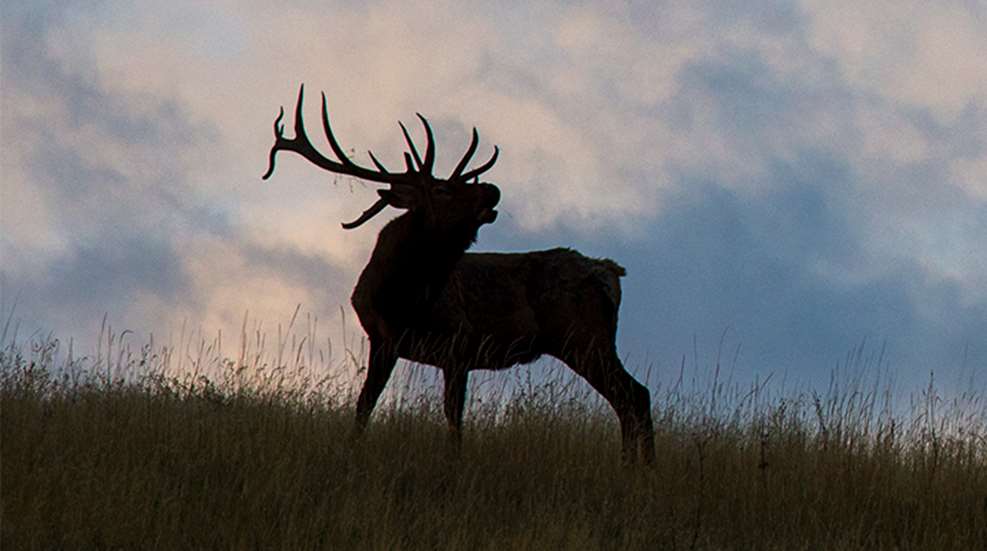
There’s a chunk of America important to all of us because of how it shaped our national character, and hunters in particular ought to know it because the hunting there is special. Head northwest from Texas’s Big Bend to Raton, N.M., and then include everything west roughly to the Four Corners in the north on down to Tombstone at the border. It’s desert landscape, grasslands, canyons, high plains and the southern Rockies. Back in the day it was cowboys-and-Indians country, a place for hard folks, fast horses and shooting straight. America’s Second Amendment was as natural as the rocks and the wind, necessary for survival, just as it can be today.
It was tough to make a living there, and many of the pioneers looking for a better life just kept going. Today’s population is still spread out. Oil and gas wells are common, semis and pickups rule the roads, and ranching still accounts for most of how the land is used.
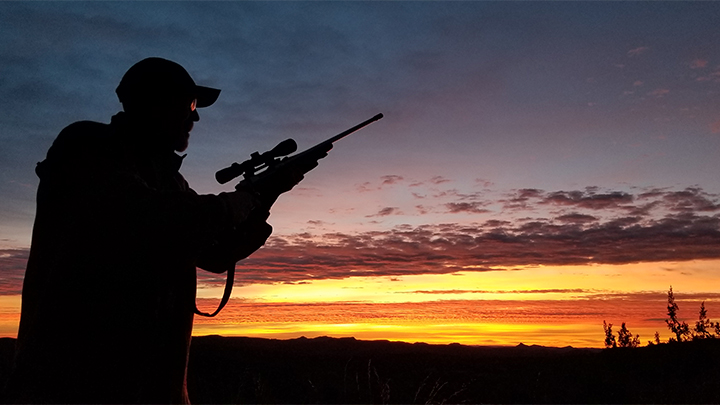
Game is spread out, too. But it’s there for the finding if you hunt hard and smart and have some luck. Elk, deer, pronghorns and javelina can be had via draw opportunities and over-the-counter tags. Introduced wildlife has flourished: feral hogs and aoudad, plus old-world antelope like oryx and ibex. The dryland quail and dove shooting are as good as anywhere. The Texas side is mostly private land, but there’s plenty of public access in New Mexico and Arizona, ample opportunity for hunters of all persuasions.
Last fall, in a convergence of American classics, Ruger’s Paul Pluff chose this prolific hunting ground for media outings featuring a couple of new versions of his company’s flagship Model 77 rifle. By teaming with outfitter Steve Jones, Paul ensured his guests would have every advantage. Steve is a friendly fellow who has long earned his keep conducting southwestern hunts and possesses a track record as good as any outfitter anywhere. He doesn’t boast or promise, doesn’t need to, and for good reason always has a positive outlook. Steve often serves firearm-industry clients, and so American Hunter editors gladly accepted spots on two of the Ruger hunts. Here are our stories.
Sweet Sounds in the Timber
You can hear about it, read about it and listen to recordings, but none of those can prepare you for the feeling that rushes through your body when you hear a bull elk bugle in the woods for the first time. Just 10 minutes into the first morning of my five-day hunt in New Mexico, I was stopped dead in my tracks as that sweet sound echoed through the timber. Music to my ears; this is what I had been dreaming of for years.
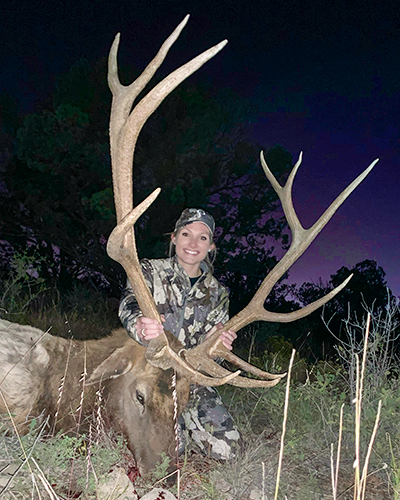
The diversity in landscape and terrain across the public land of New Mexico’s Unit 34, which spans more than 730,000 acres within Lincoln National Forest, was astounding to this Eastern hunter. It was not unusual to spend the morning trekking through the high-country timber and the afternoon glassing the vast open low-country canyons of the Sacramento Mountains, with altitudes ranging from 4,600 to 9,695 feet.
My confidence in my cardiovascular ability was quickly humbled on the first afternoon when hunting at 9,500 feet of elevation, an area my guide, Robert, called “hell hole”—a befitting name for the effort it took to hike in and out of it. Our destination was the bottom of the hole, about a half-mile down what seemed like a 90-degree hill, which opened up to a large meadow with a small wallow. I couldn’t have imagined a better elk setup.
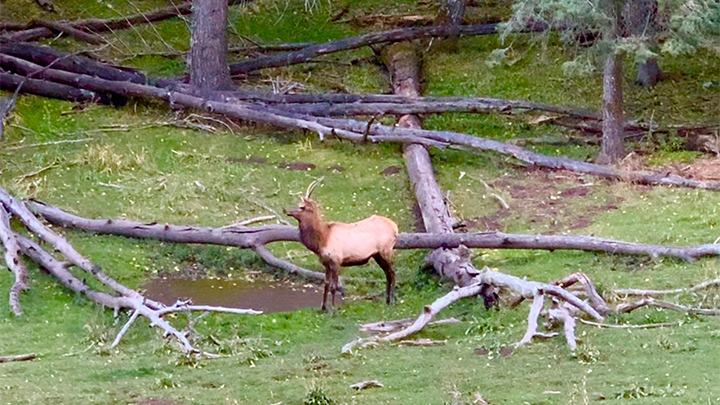
We tucked into a hide overlooking the meadow as several cows and spikes came and went from the miry wallow throughout the evening. I watched in amazement, feeling like the luckiest person in the world to have the opportunity to observe so much elk behavior in one sitting. We heard several bugles and saw a decent-sized 5x5 along the edge of the timber just before dark, but I decided to hold off on pulling the trigger, and boy am I glad I did.
Over the next few days we covered more than 40 miles of both the high and low country, bulls eluding us with the rising and setting sun. While glassing canyons early one morning, we spotted a young 5x5 and what looked to be a decent 6x6 bedded down behind sagebrush about 600 yards away. While devising a plan to close the distance, a group of three hunters crested the ridge about 150 yards from the bulls, pushing them over the ridge, never to be seen again.
That evening, while hunting the high country, about 30 minutes before last light, we heard what we were certain were at least two bulls bugling about a half-mile from us and decided to try to make a run for it. Five hundred chest-heaving yards closer to the bugles, Robert hummed on his cow call and two bulls sounded off almost instantly. There was a bull on either side of us, one of which sounded just out of sight. They screamed back and forth for about 10 minutes before deciding the cow wasn’t worth it and we heard them move off.
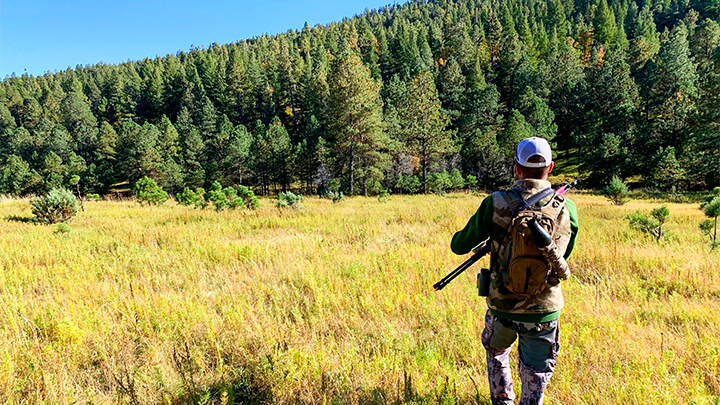
By day four, I was beginning to get nervous about the possibility of leaving without an elk, but Robert’s consistent optimism was reassuring, and I was enjoying the hunt so much that the thought of it being over was nearly as dreadful. While hunting the low country that afternoon, we spotted a herd about a mile across the canyon that contained what looked to be a nice bull.
I hoisted my rifle over my shoulder, and Robert and I ran down the canyon, stumbled through a rocky dry creek bed and crept up the side of the opposite ridge. Despite our fast-paced efforts, the wind was not on our side, and the herd spooked up and over the top before we could get a decent look. Refusing to accept defeat, with just 15 minutes of shooting light left, we sprinted straight up the steep hill in hopes that they had moved just over the ridge. As we peered over the hilltop, we saw the herd more than 600 yards away disappearing into the skyline with the setting sun.
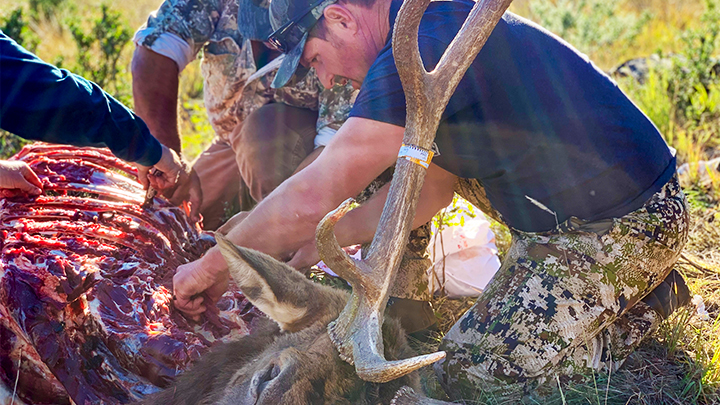
Just as I was about to sit back and catch my breath, Robert whispered, “Hold on! There’s a nice 6x6 on the side of the ridge directly across from us. Can you see him?”
“I can see him. Oh man, he’s beautiful.”
“He’s at 350 yards. Can you take that shot?” Robert asked, swiftly setting out the shooting sticks.
“Yes,” I responded, as I settled my rifle onto the sticks and fell into the zone that every hunter is familiar with: I have to get my act together, now! With my heart thumping in my ears, I controlled my breathing as much as humanly possible after running more than a mile and staring through my scope at one of the most beautiful animals I had ever seen. The bull, standing perfectly broadside, arched its neck and let out a long, booming bugle. With the sound echoing through the canyon, I pulled the trigger and my first elk was down.
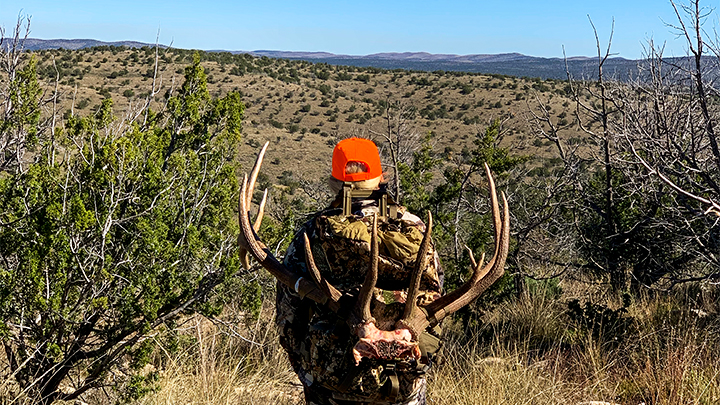
“Woo! Now that’s an elk hunt, girl!” Robert cheered. After four days of arduous hunting, numerous close encounters and many miles of captivating country, the entire experience was in fact much better than I had been dreaming of. That’s an elk hunt, indeed.—R.B
A Tex-Mex Stand-Off
Westerners make it clear they favor mobile spot-and-stalk to the kind of deer-stand hunting prevalent elsewhere and, who can disagree? Though long ago I embraced lying in wait for Mr. Big, hunting the land as well as the game is more gratifying and fun.
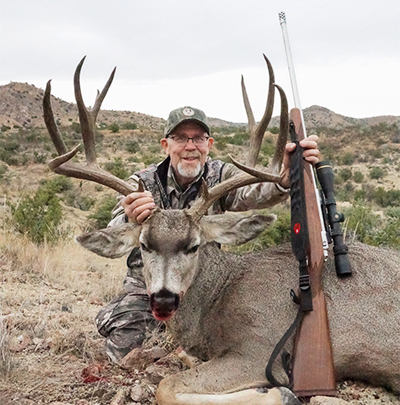
There are exceptions among Western hunters who do their scouting homework for deer, elk, bears and antelope, then hang stands in cottonwood bottoms or install ground blinds by waterholes. But there’s another kind of waiting game, one I’ve experienced on mule deer hunts two years running, and surely I can’t be the only one. This occurs at the end of a stalk, but instead of culminating right then and there, the targeted animal, though still in sight, isn’t in position for a killing shot. Most likely because it’s bedded down.
At that point it’s decision time: Get him up or wait? The former comes with the risk of spooking the critter and the likelihood of a running poke at a hind end. If the brush is tall and heavy you may not even get that look. Digging-in might also be dicey if a bull or buck is disturbed by other animals or hunters, but mostly results in unhurried shot opportunities.
It was my second visit to Steve Jones’ Love Ranch concession, many thousand acres of gnarled hills overlooking the Rio Grande and Mexico. While temperatures in the 100s and rainless months are common, there’s enough ground water and forage to support abundant wildlife.
My rifle was Ruger’s M77 Hawkeye Hunter, and though its .300 Win. Mag. chambering is more than you’ll ever need for any deer let alone small-bodied desert muleys, I’m well-versed on the .300’s trajectory and knockdown power.
Though we saw mature bucks on occasion, my days with Ruger engineer Devin Noyes and guide Dave Calloway were so enjoyable, I wasn’t anxious to pull the trigger. Besides, Devin was up first, looking for a deer he could share—through texts and photos—with his whitetail-fanatic dad back in Vermont. The 30-ish product developer, who mostly works on handguns and barrel fabrication at Ruger’s plant in Mayodan, N.C., shared his passion for building and racing dragsters and off-road vehicles, telling us he was so wrapped up in those “adrenaline sports,” he’d spent little time hunting since leaving home. So it was telling to see his excitement after a short stalk and a perfect 200-yard sitting shot on a feeding 3x4 buck, a taste of the original adrenaline sport.
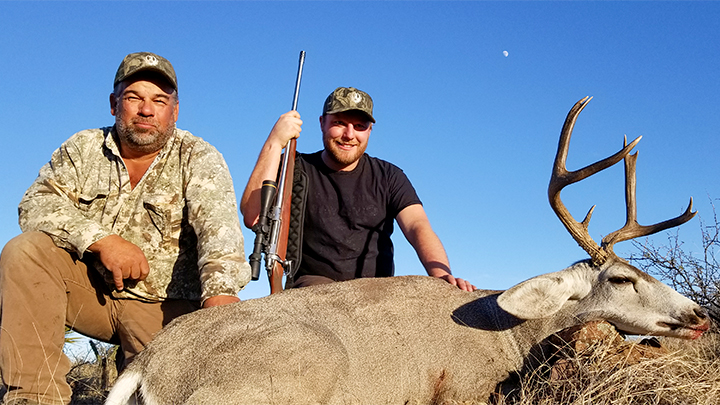
Soon after that we did find a wide-racked specimen that looked awfully good just as it ducked into a deep gully. But as soon as it reappeared on the other side, the deer hurdled the neighbor’s fence and was gone. Dave promised we’d return to that corner of the ranch at dawn and spend time sneaking into the wind to try finding the wide buck courting does frequenting the area.
Our early walkabout led to young bucks, unescorted does and a gang of shaggy aoudad before Dave got a midmorning call summoning us back to the ranch house to “talk strategy.” The strategic plan was simple: go get on a bigger buck—as in, bigger than hardly ever seen on the ranch—spotted that morning by Dr. Barry, a client whose aoudad hunt had concluded with a gagger ram he dropped on day one. The California-based anesthesiologist had decided to stay on to help us glass, and wow, did he ever, locating a true Love Ranch whopper as it settled into a series of ravines near a boundary fence. Since I was the only one left hunting mule deer, it became my good fortune and my duty to bring it in.
Ahead lay a blind stalk: Dave and I wouldn’t see the deer until in close. We advanced with Steve following behind on our uphill flank, where he could watch a bunch of country while we slipped in for a shot. Our path snaked through gullies and around massive boulders, but unspooled quickly. Inside an hour, Dave signaled a halt, glassed and then pointed out the bedded buck. Only the head was visible. The deep-forked 4x4 rack with eyeguards was wide, thick and dark as stained teak. None we’d spotted before was in this guy’s league. After crawling into a shady spot, I perched the Ruger on my sticks and checked the sight picture. “Two-seventy-five,” mouthed Dave. A textbook setup.
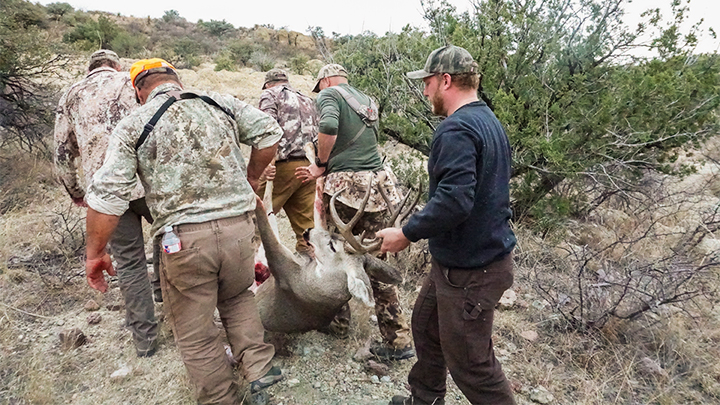
Thus began a stand-off that lasted so long it had three different acts. During High Noon we maintained red alert, barely moving or trading so much as a whisper. Our quarry dropped his head and fidgeted a bit, but stayed put until two cow elk passed by. That clearly got his attention, though he remained motionless until they were gone, whereupon he finally hopped up right behind a line of chaparral. That began the Restless Sleeper phase, during which the big muley got up and moved three times. Incredibly I could not “see” a clear shot any of those times. Likely I missed a fleeting chance or two, but the little range officer in my head who says “fire!” stayed mum. Between tall brush, awkward angles and the deer’s walking speed, I couldn’t pull it off. He shifted in a meandering circle, and after the third move ended up exactly in his starting spot. It was late afternoon by then, time for a Power Nap, as he rested his heavy head on the ground and barely twitched. Dave and I fought to stay focused. Lying sideways, the guide piled up a makeshift stool, sliding one rock at a time under my butt. That helped ease my aching back, but only a little. Somewhere behind, Steve was really leaning into his squealer call, which thus far had failed to arouse any interest. It was starting to get dark when Dave finally said he was ready to roust the buck.
Maybe the guide should have said so earlier, because at that moment the buck sprang to his hooves, took a step then lurched as I fired. Momentum carried him some 40 yards before we saw him drop. I sure was stiff and sore crossing the deep ravine to get to the deer, and still in kind of a daze after being on edge for so long. It was a little past 5 o’clock, nearly six hours since the standoff began. Every minute was a thrill, but don’t tell me Western hunting doesn’t involve a lot of sitting.—J.Z.
One reason why the Ruger Model 77 rifle has been a mainstay in American hunting camps for 50-plus years is its steady stream of innovative model variations. Constants include legacy features like controlled-round feed and an angled front guard screw for superior strength, plus the highly regarded LC6 trigger.
Today’s M77 Hawkeye generation follows suit with long-range precision models tailored for tactical and competition applications, as well one that’s hunting-specific. On the other hand, Ruger hasn’t forgotten its bolt-gun roots, but has now joined the familiar walnut stock to all-stainless metalwork. Shared new features include muzzle threading and, along with integral mounts machined into the receiver, a supplied 20 MOA Picatinny rail mount that affords superior elevation adjustment at long range. Barrels are cold-hammer-forged in-house with 5R rifling, which reportedly causes less stress on the bullet and less bore fouling.
Thus, the Hawkeye line remains in step with evolving shooter preferences, but sticks to two stubbornly appealing traits the ambitious gunmaker relied on right from the start: ruggedness and real value.
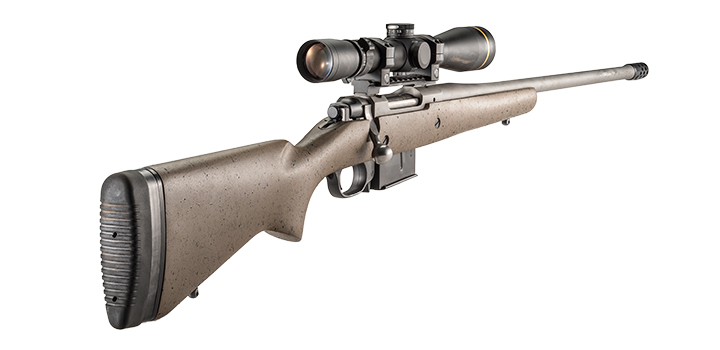
Hawkeye Long-Range Hunter
Hunters seeking long-range performance in a lightweight, accurate, rugged rifle need look no further than the Long-Range Hunter. It is chambered in two short-action calibers designed to optimize accuracy and terminal performance at distance: 6.5 Creedmoor and 6.5 PRC.
Weighing in at 7.2 pounds, the Long-Range Hunter features a 22-inch, free-floated, cold-hammer-forged stainless-steel barrel that delivered incredible accuracy in my hands. It comes with a radial port muzzle brake to reduce felt recoil, though I found it a bit unnecessary to “tame” the minimal recoil of my 6.5 PRC rifle. That said, its ⅝x24 muzzle threading allows hunters to remove the brake and replace it with a suppressor or muzzle cap.
The rifle’s laminated hardwood stock is covered in a speckled black/brown epoxy finish, which provides a comfortable, secure grip and protects the wood from the elements. Long-range accuracy requires proper fit, and hunters can adjust the length of pull from 12.75 to 14.25 inches using half-inch spacers between the stock and rubber buttpad. A removable AI-style detachable box magazine holds five rounds of 6.5 Creedmoor and three rounds of 6.5 PRC.
As far as the aforementioned accuracy, Hornady’s 6.5 PRC 143-grain ELD-X Precision Hunter load that I used to take my bull consistently produced sub-inch, three-shot groups at 150 yards.—R.B.
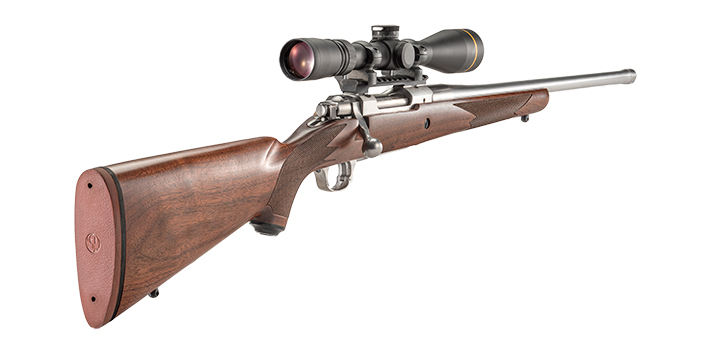
Hawkeye Hunter
At first glance, the Hunter is kind of a throwback, right down to its red rubber buttpad. Today’s walnut stocks are a bit sleeker than earlier ones, yet promise the same smooth handling. Pairing them with a matte-stainless barreled action gives the rifle a hero look: handsome and durable. A wide range of calibers—from .204 Ruger to .300 Win. Mag.—covers the gamut of hunters’ needs, and there are even left-hand offerings.
The bottom metal is also steel—no plastic to be found on this gun—and its hinged floorplate is released by a latch set flush into the trigger guard to prevent accidental opening. The rifle’s controls are top-notch, including a side-swing safety that will lock the bolt or allow shooters to load/unload while on “safe.” Our test rifle’s LC6 trigger broke right at 3 pounds after short take-up, and overtravel was almost nil. That sure helped at the bench, where my test rifle reliably grouped a stout .300 Win. Mag. Federal Fusion 180-grain load at 1.1 inches.
To reuse past Ruger terminology, the Hunter is an all-purpose rifle for our times, as suited to trekking open country as it is to holding down the fort. Plenty of M77s have been designed to do so, but few have boasted the heirloom quality of the Hawkeyes.—J.Z.




































